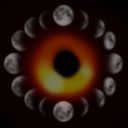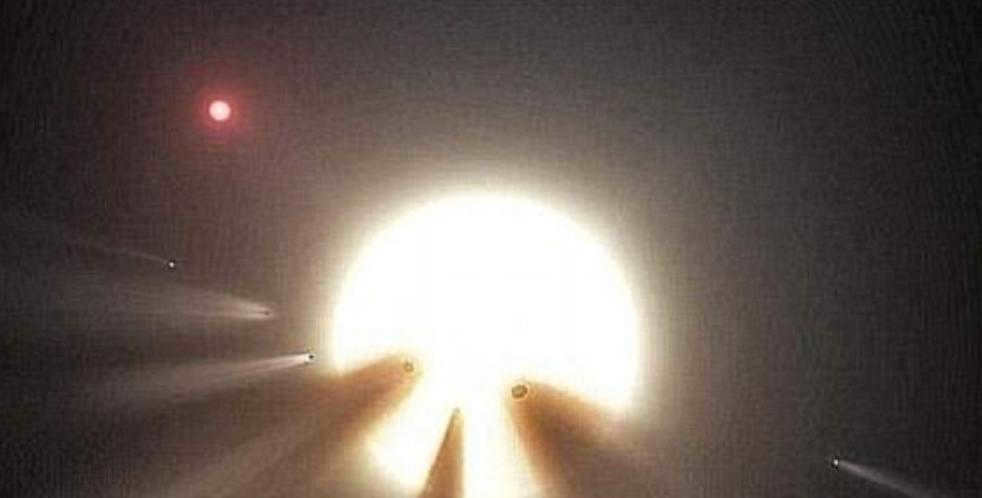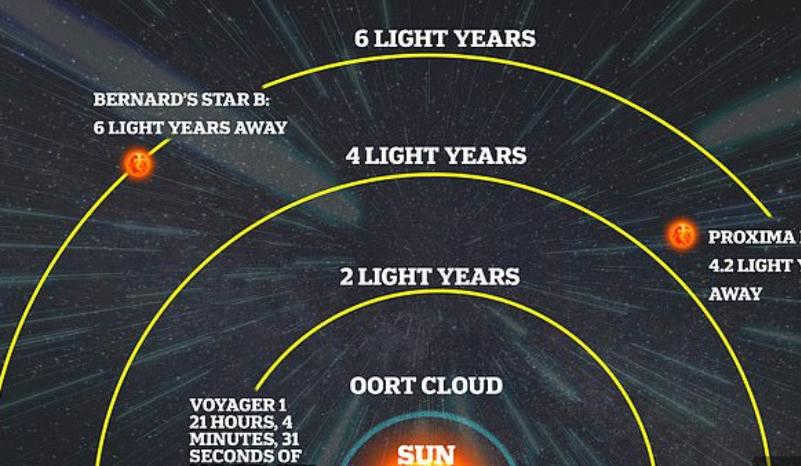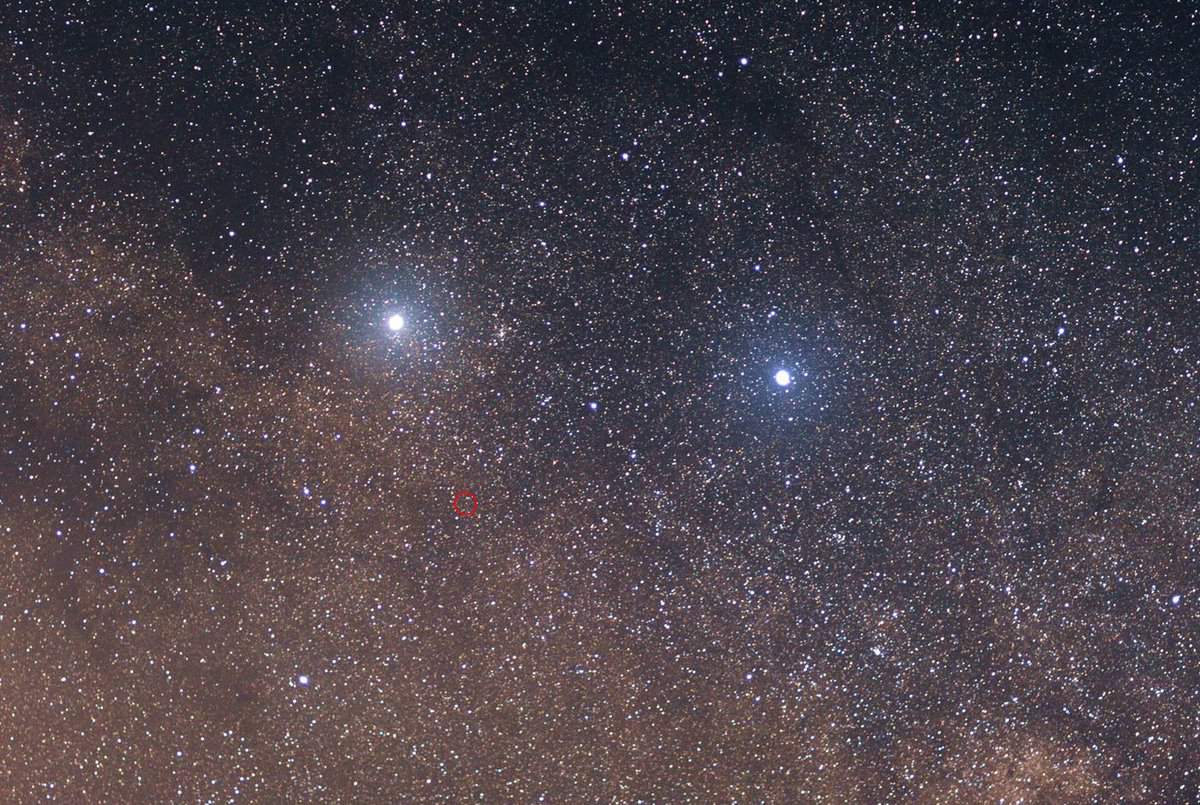For those curious about the dimensions of the Pillars of Creation, we have an informative visual infographic that illustrates the proximity of Proxima Centauri to the nebula in relation to our solar system.

What is the estimated time for a spacecraft to reach Proxima Centauri, the nearest star?
Proxima Centauri, located 4.2 light-years away from Earth, is equivalent to approximately 6 trillion miles – the distance that light can travel in one year.
Let’s consider the New Horizons spacecraft, which was originally designed to explore planets.
During its mission to Pluto, it was able to achieve a speed of 52,000 miles per hour.
At this rate, the spacecraft could cover a distance of 1.2 million miles per day and approximately 455 million miles in a year. Based on this speed, it would take around 12,905 years to travel a single light-year and roughly 54,000 years to reach Proxima Centauri.
Preparing for the upcoming school year
Choosing the Right Gadgets for Your Child’s Education and Hobbies
With the start of the school year just around the corner, it’s time to start preparing your shopping list. Besides the usual pens and notebooks, modern students can’t do without gadgets – some for their studies, others for their hobbies. We’ve gathered a selection of gadgets that are definitely worth considering.
If you make a purchase of 5000 rubles or more at Megamarket before August 31, and use the promo code PIKABU23, you’ll receive a discount of 800 rubles.
VR Headsets: Experience the World of Virtual Reality

If your child has aspirations of exploring the vastness of the universe, consider purchasing virtual reality goggles for them. These innovative gadgets allow users to transport themselves into various realms and experiences, whether it be as an astronaut, airplane pilot, dinosaur explorer, or even a conqueror of magical dungeons. Equipped with built-in headphones and a high-quality display, these goggles provide a truly immersive virtual reality experience. Parents may also find themselves intrigued by the possibilities offered by these devices.

If your kid has been attending an art school for quite a while or simply has a deep interest in sketching, it is high time to start getting acquainted with the digital wave. In such a scenario, a graphics tablet becomes an essential tool. With its help, you can craft digital artwork or edit photographs. The XP-Pen Deco 01 V2 boasts an expansive working area, measuring 25 by 15 centimeters, and offers a superb pen response speed, ensuring minimal lag. Additionally, it comes bundled with extra nibs and a glove to facilitate smooth gliding across the surface.
Video Projector

Watching films is an activity that unites children and parents. With a projector, you can easily create a mini cinema at home. The compact Wanbo Projector T2 Max takes up very little space, yet it produces high-quality 4K images. The trapezoid correction function allows you to set up an even, distortion-free picture from any angle. In addition to the projector, consider getting a screen for an even better viewing experience.

As you progress through each year, the number of textbooks and supplementary reading materials increases. To avoid the hassle of carrying them back and forth to your grandparents’ house and to have the ability to read even while on the go, consider using an e-book. The Digma K1’s screen replicates the appearance of real paper and ink, resulting in less eye strain compared to using a smartphone or tablet.
Mobile phone

It is difficult to envision a student without a smartphone in the present moment. To begin with, you have the option to purchase a basic and affordable smartphone model, such as the Itel Vision 3 Plus. This model offers a spacious screen measuring 6.82 inches diagonally, 4 GB of RAM, and 64 GB of internal storage. It also includes two primary cameras and a 6000 mAh battery, making it an ideal choice for those looking to satisfy their child’s desires while working within a limited budget. Additionally, wireless headphones are included in the package.
Electronic Device: Tablet

The Xiaomi Redmi Pad is a versatile device that is perfect for both studying and entertainment. With its 10.6″ screen diagonal, powerful surround sound, low blue light display, and 8000 mAh battery, it provides an immersive and enjoyable experience. It also functions as a reader, allowing you to easily download and read books on the tablet.

Smartwatches have been specifically designed for children and primarily offer benefits to parents. These devices enable parents to easily track their child’s geolocation, make calls, and even listen to their surroundings in real-time. With a battery life of up to 50 hours, these smartwatches provide long-lasting functionality. The call volume is sufficiently loud, however, only pre-approved contacts from the “white” list will be able to make calls. This makes them a fantastic alternative to smartphones during lessons, as children can stay connected without being distracted by games.
Notebook

When it comes to finding the ideal gift for a high school student or aspiring college student, a laptop is the ultimate choice. From completing reports and essays to accessing e-textbooks, taking online tests and participating in Olympiads, a laptop is an essential tool for modern students. The MAIBENBEN M547 is the perfect laptop for tackling work tasks, with its 15.6″ screen boasting a resolution of 1920×1080 pixels, 8 GB of RAM, and 256 GB SSD storage. Despite its powerful performance, this laptop weighs less than two pounds, making it incredibly portable.

Make sure your desktop computer or laptop is equipped with speakers, a headset, a mouse, and a mouse pad to create a fully functional workspace.
Don’t forget about the printer!

If you believe purchasing a printer would be a wise decision, I’m afraid you’re mistaken. Handwriting abstracts is no longer necessary, and continuously printing documents at copy shops can become quite costly. Additionally, certain study resources are exclusively available online, making it much more convenient to utilize them in a printed format.
Multiplayer First Person Shooter

If you find that the printing capabilities alone are insufficient, you may want to consider purchasing a multifunction printer (MFP) that includes a scanner and copier. One such option is the Canon PIXMA, which is a versatile model capable of printing both documents and photos with exceptional detail.

For active children during the academic year, this fitness bracelet makes an excellent present. It monitors various aspects of your health, such as blood oxygen levels, heart rate, calories burned, steps taken, distance covered, and many more. Additionally, it enables you to stay connected by receiving calls and notifications from social media platforms and messaging apps. You can also utilize it as an alarm clock or to locate your phone if misplaced.
Portable Power Bank

A savior for those who enjoy spending time on their smartphones. The Xiaomi Redmi 18W Fast Charge Power Bank, with a capacity of 20,000 mAh, is capable of charging your smartphone three to four times on average. This model is equipped with two USB outputs and two input connectors: Type-C and micro USB. It becomes an essential item when your phone’s battery is running low and there’s no power outlet nearby.
Remember to use the promo code PIKABU23 to get an 800 ruble discount when ordering from Megamarket for a minimum purchase of 5000 rubles until August 31.

New exoplanet – Proxima d
A new discovery has been made in the field of astronomy, as scientists have found another planet orbiting Proxima Centauri, the closest star to our solar system. This newly discovered planet, named Proxima d, is quite unique in its characteristics. It has a mass that is estimated to be only 25% the mass of Earth, making it one of the lightest exoplanets ever discovered. In fact, it is about twice the mass of Mars. The discovery of Proxima d was made possible through the use of the Very Large Telescope in Chile. A team of researchers used the radial velocity method to study the gravitational pull of orbiting planets on the star. By observing the star’s oscillations, they were able to determine that there is a high probability of a third planet in the system. Proxima d orbits its host star at a distance of 0.029 times the distance between Earth and the Sun, which places it in the habitable zone of Proxima Centauri. The habitable zone is a region around the star where conditions are favorable for liquid water to exist. This exciting discovery opens up new possibilities for further exploration and understanding of the universe.

The puzzle of the “extraterrestrial” radio signal from Proxima Centauri resolved
It has been revealed that the signal detected in the direction of the closest neighbor to our solar system most likely originates from Earth. The findings of the analysis of the signal were presented by scientists in the scientific journal Nature Astronomy.
An artist’s rendering shows a starburst on Proxima Centauri, which was detected using nine telescopes, including the Atacama Large Millimeter/submillimeter Array (ALMA). Proxima Centauri experiences powerful flares like this on a regular basis. Source: S. Dagnello, NRAO/AUI/NSF
In 2020, the breakthrough Listen project first identified the signal, as part of an effort to find signs of advanced alien civilizations, known as “technosignatures.” The project utilizes some of the world’s largest radio telescopes to monitor celestial targets in the depths of the night sky, searching for extraterrestrial radio signals.
As part of the project, Proxima Centauri was specifically targeted for observation. The star was carefully monitored using the radio telescope at the Parkes Observatory in Australia, with frequencies ranging from 700 MHz to 4 GHz and a resolution of 3.81 Hz. Since 2016, astronomers have detected over 4.1 million frequency bands in the direction of Proxima Centauri, some of which showed potential signs of interesting radio signals. However, after thorough automatic selection and meticulous manual inspection, only one signal remained. This signal, named BLC1, was considered the most promising candidate for a potential “first contact” with extraterrestrial life, until its mystery was ultimately unraveled by radio astronomer Sophia Sheikh from the University of California at Berkeley.
Sheikh discovered approximately 60 signals resembling BLC1, but failed to meet one of the criteria for confirmation – specifically, these signals did not vanish when the telescopes “turned away” from the alleged source. This has prompted scientists to suspect that BLC1 is not a technosignature either.
Instead, BLC1 is the outcome of abnormally strong local interference. Its characteristics are significantly distinct from other instances of interference, which is why it bears such a striking resemblance to a genuine technosignature.
Andrew Semion, the scientific director of the Breakthrough Listen project
It transpired that BLC1 and 60 similar signals are evenly spread across the frequency range represented in the data, with the distance between them being a multiple of the frequencies employed in numerous electronic devices.
It proved to be a challenging task to ascertain the non-extraterrestrial origin of this signal. Our radio interference removal algorithms were ineffective in filtering it out, and it took us an extensive period of several months to discover that it was of human origin. BLC1 holds the distinction of being the most extensively examined signal in the annals of SETI.
Breakthrough Listen is currently engaged in ongoing observations of Proxima Centauri, and the investigation of BLC1 has provided scientists with an opportunity to enhance their algorithms for distinguishing genuine signals from background noise. Additionally, the project has plans to incorporate the as-yet unfinished radio interferometers MeerKAT (South Africa) and Very Large Array (USA).

We have recently detected a new signal from Proxima Centauri! (Signal: BLC2)
In December 2020, astronomers successfully received a signal from Proxima Centauri, the closest star to our planet. The signal was identified as BLC1, also known as “Breakthrough Listen Candidate 1”. Now, a second signal named BLC2 has been detected. However, instead of being of extraterrestrial origin, this signal appears to originate from a source much closer to us.
Breakthrough Listen reveals findings on the signal originating from Proxima Centauri.
An intriguing signal that was captured by the Breakthrough Listen project last year has undergone a thorough analysis, leading researchers to believe that it is unlikely to have originated from the Proxima Centauri system. Instead, it is believed to be a result of terrestrial interference from human technology. Two scientific papers published in Nature Astronomy discuss both the discovery of the signal and an advanced data analysis method that can accurately identify “false positives.”
“The significance of this finding is that the search for extraterrestrial civilizations has now become a mature and rigorous field of experimental science,” said Yuri Milner, the founder of Breakthrough Initiatives.
Breakthrough Listen, an astronomical science program under Breakthrough Initiatives, aims to detect technosignatures – evidence of extraterrestrial technology. Dr. Andrew Semion from the University of California, Berkeley leads the Listen science team, which utilizes some of the world’s largest radio telescopes and advanced digital processing systems to collect data across various radio frequencies from different celestial targets. The search is challenging due to the abundance of radio signals from human-made technology, such as cell phones, radar, satellites, and television transmitters. It is like searching for a needle in a constantly changing digital haystack when trying to identify a faint signal from a distant star.
The Breakthrough Listen search includes participation from CSIRO’s Parkes telescope, located in New South Wales, Australia. This telescope, known as “Murriyang” in Wiradjuri, is one of the largest in the Southern Hemisphere. Among its tracking targets is Proxima Centauri, the closest star to the Sun, situated approximately 4 light-years away. Proxima Centauri is a red dwarf that has two known exoplanets in orbit. The Listen team conducted a thorough scan of this target across a frequency range of 700 MHz to 4 GHz, with a resolution of 3.81 Hz. This scan is equivalent to tuning into more than 800 million radio channels simultaneously, with exceptional detection sensitivity.
When making observations, Listen applies two basic criteria to filter out signals:
Firstly, it checks if the frequency of the signal changes continuously over time. This is because a transmitter on a distant planet is expected to move relative to the telescope, causing a Doppler shift similar to the change in pitch of an ambulance siren as it moves relative to an observer. By rejecting signals that lack evidence of this motion, the number of matches is reduced from 4 million to about 1 million.
Secondly, for the remaining signals, Listen determines if they are coming from the direction of the target. To do this, the telescope is pointed towards Proxima Centauri and then away, repeating this ON-OFF pattern multiple times. Local sources of interference are expected to be detected in both the ON and OFF modes, while techno-signatures should only be present in the ON observations.
Despite the implementation of both of these filters, there remain a few candidates that require visual inspection. Occasionally, a faint signal is detectable in the OFF observations, but it lacks the necessary strength to be detected by the automated algorithms. On occasion, comparable signals manifest in adjacent observations, suggesting the presence of interference sources that intermittently activate when least desired. Alternatively, the team may be monitoring signals emitted by satellites that typically transmit within specific frequency ranges.
Occasionally, there is an intriguing indication that requires further investigation. Smith came across such a fascinating indication while observing Proxima Centauri with the Parkes telescope as part of Listen’s research. The indication was a narrow-band Doppler-shifted signal that persisted for five hours, appearing only during the “ON” mode of star observations and not during the intermittent “OFF” observations. This signal exhibited some of the expected features of a potential technosignature.
Dr. Sophia Sheikh, a researcher in the Listen group at the University of California, Berkeley, analyzed a larger set of observations collected at different times. She discovered approximately 60 signals that shared many characteristics with the initial candidate signal, but these signals were recorded during the “OFF” observing mode.
According to Sheikh, it can be confidently stated that these additional signals are specific to the telescope and are generated by humans. The signals are evenly spaced at regular frequency intervals in the data, which align with the frequencies used by common oscillators in electronic devices. Collectively, these findings suggest that the interference is caused by human machinery, although the exact source has not been identified. When the telescope is not pointed at Proxima Centauri, the original signal detected by Shane Smith cannot be detected. However, considering the multitude of signals present, the most plausible explanation is still that it is a signal originating from human technology that happens to possess the necessary attributes to deceive our filters.
Breakthrough Listen has made all of the data from Parks’ scan available to the public for independent study. Additionally, the team has recently released two papers (led by Smith and Sheikh) that provide detailed information about the collection and analysis of the data. They have also published a research note that describes additional observations of Proxima Centauri made in April 2021 using the Parkes telescope. Breakthrough Listen will continue to monitor Proxima Centauri, as it remains an enticing target for searching for technosignatures, utilizing a variety of telescopes located around the globe. The team is also constantly refining their algorithms in order to improve their ability to distinguish between significant findings and background noise. To aid in this effort, they recently collaborated with kaggle on an outsourced data processing competition.
“Regarding this specific candidate,” Simion states, “our investigation indicates that it is improbable for it to originate from a transmitter situated on Proxima Centauri. Nevertheless, it is undeniably one of the most captivating signals we have encountered thus far.”
Recently, inhabitants of Earth stumbled upon an enigmatic radio signal that was transmitted from the vicinity of the star Proxima Centauri. Currently, a group of astronomers dedicated to the pursuit of extraterrestrial life is closely examining it. Researchers from the Breakthrough Listen Project, a venture established with a budget of $94 million to conduct a quest for alien existence using radio telescopes, have been thoroughly examining these radio waves since April 2019. More details about the astronomers’ recent discovery will be discussed below.
An astonishing broadcast

According to The Guardian, Proxima Centauri is situated 4.2 light-years away from our planet. The signal in question was picked up by the Parkes radio telescope, which is located in New South Wales, Australia. This detection took place sometime between April and May of 2020, and unlike previous radio bursts, it was not linked to any known terrestrial source near Earth.
While there is a possibility that this pulse has a natural explanation, astronomers are thoroughly investigating it. This discovery is being hailed as one of the most significant radio pulses since the famous “WOW!” signal was recorded back in 1977. The researchers involved in this study speculate that it could potentially be a message sent by an extraterrestrial civilization from a distant location.

Proxima b, a planet with a similar composition to Earth, is orbiting within the “habitable zone” around Proxima Centauri. This zone is where it is possible for water to exist in a liquid state on the planet’s surface. However, due to the fact that Proxima Centauri is a red dwarf star, the “habitable zone” is located very close to the star. As a result, Proxima b may be exposed to increased levels of radiation and experience tidal acceleration, making it unlikely that any form of civilization is developing on its surface.
Scientists have discovered a radio burst in the 980 MHz range, and the frequency shifts detected by the Parkes telescope match the motion of Proxima b. Upon analyzing this data, researchers have proposed the existence of a third planet within the system, rather than an extraterrestrial civilization, which they consider to be highly improbable.
What Pete Worden stated

“The signals may be interference from sources on Earth that we haven’t yet been able to explain,” said Pete Worden, the head of Breakthrough Initiatives, in an interview with The Guardian. “However, we should exercise patience and await the project scientists’ findings following a thorough analysis of the signal.”
Astronomers claim that this recent radio burst bears a striking resemblance to the famous “WOW!” signal discovered in 1977 by the Big Ear radio observatory in the United States. Until now, the “WOW!” signal has served as the most compelling evidence for experts in the field of extraterrestrial intelligence research. Nevertheless, even to this day, very little is known about the origin and nature of these signals.
Proxima b: An Introduction

Proxima b, the exoplanet closest to Earth and the nearest planet to the star Proxima Centauri, completes a full orbit around its star in 11.2 Earth days and has a mass approximately 1.2 times that of our home planet. This rocky celestial body is exposed to stellar winds that are 2,000 times more intense than Earth’s solar winds.
Despite being located within a region where liquid water could potentially exist, the presence of these strong stellar winds diminishes the likelihood of life emerging on Proxima b. Discovered in August 2016, it is currently believed to be tidally locked, further complicating its potential habitability. Due to these factors, the true habitability of Proxima b remains uncertain.

Research indicates that Proxima b could potentially have oceans and a thin atmosphere, although this has not been verified. Confirmation about the presence of water and an atmosphere on the planet can only be obtained by observing its transit in front of its star, which has not yet occurred.
If Proxima b does indeed contain water and an atmosphere, despite the intense radiation, it is possible that life could have developed on the planet. Scientists are hopeful that the James Webb Space Telescope, set to launch next year, will be capable of detecting the planet’s atmosphere. Additionally, there is a proposed mission to send a probe to Proxima b in 2069 to search for signs of life.
Statement from Lewis Dartnell

The research findings of the Breakthrough Listen team are currently being prepared for publication, although an official release date has not yet been determined. The initiative was launched in 2015 by Yuri Milner, a tech investor from Silicon Valley. Its purpose is to actively search for intentional or unintentional signals transmitted by extraterrestrial civilizations and is planned to continue for the next ten years. As part of this project, experts are actively monitoring for any potential signs of human-made objects and technosignatures within the range of bursts originating from deep space.
Findings of the previous research

According to a previous study conducted by experts from the Sydney Institute, Proxima Centauri frequently emits coronal mass ejections that have a detrimental impact on its neighboring rocky planet. This finding is based on a distinct radio burst, which is believed to have originated from a superflare of the star or an extremely powerful emission.
These superflashes have the potential to eradicate all forms of life on a nearby planet, and Proxima b happens to reside in this perilous vicinity, probably receiving occasional bombardments of preserving particles. Additionally, the planet likely experiences tidal acceleration, similar to the Moon’s orbit around the Earth. Consequently, one side of Proxima b is perpetually illuminated while the other remains in darkness.

“It’s difficult to fathom the existence of a stable climate system and all the necessary conditions for bacteria to evolve into intelligent life forms. It’s highly unlikely that such a scenario exists,” Dartnell stated. “However, I am open to being proven wrong.”
It is plausible that there are other planets situated at a greater distance from Proxima Centauri that have not yet been discovered by astronomers. However, these planets are likely too far from the star to have water present on their surfaces.

Proxima Centauri is the nearest star to our planet. Many enthusiasts of science fiction and other imaginative individuals have long been fascinated by this celestial body. It is understandable since, if humanity were to develop the technology to travel between stars at reasonably fast speeds, Proxima Centauri would logically be the primary target. However, does it truly make sense? Is it worthwhile to journey first to a star where life is simply not possible? The truth is that Proxima Centauri is an extremely hostile star. Periodically, it releases intense bursts of energy that would undoubtedly exterminate any known form of life…
In 2016, scientists made a fascinating discovery near the star Proxima Centauri – an exoplanet called Proxima Centauri b. This exoplanet is of particular interest due to its close proximity to our solar system, just 4.24 light-years away, making it an ideal target for further study. What’s more, Proxima Centauri b is located within the habitable zone of a red dwarf, which are the most abundant type of stars in the main sequence, accounting for approximately 75% of all stars. Therefore, it is understandable why there is such a great deal of interest in this exoplanet.
Gaining a deeper understanding of how red dwarfs behave and the conditions they create is a captivating question. However, it appears that the situation surrounding Proxima Centauri is not as favorable as one might hope.
While carefully observing the star, scientists were suddenly astonished by a remarkable discovery that rendered Proxima Centauri b uninhabitable. It was an unprecedentedly potent flare emitted by Proxima Centauri!
Red dwarfs are classified as low-mass, low-luminosity stars. The majority of them exhibit variability in their brightness. They are relatively unstable in comparison to other types of main-sequence stars. Specifically, red dwarfs are highly susceptible to eruptions, which manifest when the star’s magnetic field undergoes abrupt changes, propelling electrons to velocities nearing the speed of light.
Proxima Centauri. The Flare Mechanism
By interacting with the plasma of the star, these electrons trigger a strong outburst, resulting in the emission of radiation across the entire electromagnetic spectrum. To assess the occurrence rate of flares on Proxima Centauri, scientists conducted a 40-hour observation of the star over a span of several months in 2019. This investigation involved the utilization of various telescopes, including ASKAP in Australia, ALMA in Chile, the Hubble Space Telescope, the TESS Space Telescope, and the Las Campanas Observatory Telescope.
The mega-flare on May 1, 2019 was detected by the telescopes, which observed a significant increase in radiation levels across multiple parts of the electromagnetic spectrum. The telescopes were able to capture detailed information about the energy and duration of the flare. In just a matter of seconds, the star’s brightness in the ultraviolet reached a level 14,000 times higher than normal. If there is life on Proxima b, these mega-flashes from Proxima Centauri would be incredibly destructive. Any potential life on Proxima b would have to be vastly different from life on Earth in order to survive.
Red dwarf stars, such as Proxima Centauri, are typically very faint. As a result, flares that occur in the visible part of the electromagnetic spectrum are often not easily observable from Earth.
Why is this necessary?
It is essential to conduct the 2019 research as it provides a comprehensive analysis of starburst anatomy within the Milky Way. In the future, these signals could offer valuable insights into the triggering mechanisms of these flares, thus greatly aiding scientists in their exploration of exoplanets.
Regrettably, the situation does not bode well for Proxima b. The flares emitted by Proxima Centauri make the exoplanet inhospitable for life, at least as we currently understand it.
Proxima Centauri, being of a similar age to our sun, holds the potential for hosting life on a nearby planet that has had sufficient time to develop. However, during this period, the star has continually unleashed countless lethal megaflares throughout its system.
Despite the evident challenges, many astronomers still consider exoplanets to be the most promising sites in the search for extraterrestrial life.

Undoubtedly, the Sun is the nearest star to our planet, located approximately 150 million kilometers away. Despite its close proximity, we often overlook the fact that the Sun is, in fact, a star due to its significant influence on our daily lives and cultural significance. When we think of stars, we typically envision the brilliant celestial bodies that adorn the night sky. It would only be logical to assume that one of these stars would be the closest to our Sun.
Distances to the stars
For a considerable period of time, it was widely believed that the star in question was Alpha Centauri, which is located 4.3 light-years away. Its prominence in the southern sky makes it quite noticeable and it ranks as the third brightest star.
However, determining the distance to any star is not a straightforward task. While observing and detecting stars is relatively simple, accurately measuring their distance is a more complex endeavor. This requires the use of powerful telescopes to observe increasingly faint stars. By exposing a long-exposure photograph of the night sky, one can uncover thousands of similar objects that are otherwise invisible to the naked eye.
Indeed, this footage provides a clear indication of the star’s location in the sky. However, ascertaining its distance remains a challenge. To determine this crucial information, we must delve into the concept of parallax, which refers to the apparent shift in a star’s position as a result of the Earth’s orbital motion around the Sun. By observing the star from different perspectives during these moments, we can gather valuable data. It is worth noting that the utilization of this method is relatively recent, dating back to the 19th century.
Nevertheless, even in present times, measuring the distance to stars is no simple feat. It necessitates capturing multiple images at different intervals and meticulously analyzing them to determine the star’s distance accurately. This task becomes particularly arduous when dealing with faint stars.
That's why the nearest star to us was only identified in 1915. It was spotted by Scottish astronomer Robert Innes during his observations of the southern hemisphere sky at the Johannesburg Observatory in South Africa. Amongst the images, he came across a very dim star in close proximity to Alpha Centauri. While discovering faint stars is not uncommon, this particular find was extraordinary.
After two years, the newly found star had its parallax precisely measured by Dutch astronomer Joan Voigt at the Cape Town Observatory. The surprising result was that this star is actually slightly closer to the Sun than Alpha Centauri, at a distance of 4.2 light-years! This exciting discovery inspired Robert Innes to propose the name Proxima Centauri for this celestial object, highlighting its status as the closest star to our Sun. The term “Proxima” originates from Latin and means “nearest”. Over time, this star has been given other names as well. It is sometimes referred to as Alpha Centauri C and in other instances as V645 Centauri.
Proxima Centauri cannot be seen with the naked eye because it is too dim. Despite being the closest star to us, it would need to be a hundred times brighter to be visible without a telescope. This means that Proxima Centauri is a very tiny object. It is classified as an M dwarf or red dwarf, with only a tenth of the mass and 15 percent of the radius of our Sun. As one of the smallest stars in existence, it would not be able to convert hydrogen into helium at its core if it were any smaller, resulting in it being classified as a brown dwarf by astronomers.
A Star with Flaring Characteristics
However, Proxima Centauri is not simply a red dwarf; it is classified as a flaring star. This unique classification implies that it experiences periodic changes in brightness. The fluctuating brightness of Proxima Centauri is primarily attributed to its magnetic activity, which is significantly stronger compared to our Sun. Unlike our Sun, where hydrogen is only converted to helium in its core, in Proxima Centauri, this process occurs throughout the star due to the convection currents that reach the core. As a result, the helium produced by nuclear fusion is dispersed throughout the star, instead of accumulating in the core.
Proxima Centauri’s interior experiences convection, which results in the continuous movement of the electrically charged plasma comprising the star and the generation of a powerful magnetic field.
These bursts of brightness that occur when the energy stored in this field is discharged are what give Proxima its flaring star status.
The Inaccurate Trio
The alternate designation of the celestial body provides insight into its relationship with its neighboring stars. The moniker “Alpha Centauri C” implies that Proxima is not simply in close proximity to Alpha Centauri by chance. In reality, it is part of a binary star system. Or, to be more accurate, a trinary star system. Alpha Centauri itself is already a binary star, consisting of two components, Alpha Centauri A and Alpha Centauri B. Therefore, Proxima Centauri, as the third member, is referred to as Alpha Centauri C. However, it remains uncertain whether this name is truly accurate. The separation between components A and B is only 24 astronomical units, which is only slightly greater than the distance from Uranus to the Sun.
Proxima Centauri is positioned 15,000 astronomical units away from components A and B, which equates to approximately 0.2 light-years! Due to this vast distance, astronomers have raised doubts about the existence of this peculiar multiple system. The orbital period of Proxima around the double star Alpha Centauri is estimated to be around half a million years, making it an incredibly slow-moving object. Consequently, confirming its association with the Alpha Centauri system poses a challenge, as it is possible that Proxima Centauri simply happened to come into close proximity by pure chance. Only through more extensive and precise observations can we determine whether Proxima Centauri is truly a solitary celestial body or not.
Regardless of the circumstances, Proxima Centauri now holds the distinction of being our nearest celestial neighbor in the vast expanse of space.
Distant Exoplanets
Naturally, there is immense curiosity surrounding the possibility of distant exoplanets. The existence of worlds that are relatively close to us and orbit around a dim star like Proxima Centauri would provide a fascinating subject for astronomers to investigate!
Currently, scientists have identified three potential exoplanets in this system. They have been designated Proxima Centauri b, c, and d. These exoplanets have sizes comparable to Earth. However, it is highly unlikely that any of them are suitable for sustaining life. Both planets b and c are situated at distances from Proxima that are too far (0.5 and 1.5 astronomical units, respectively) for them to maintain a warm enough temperature. As for planet d, it may face other challenges.





